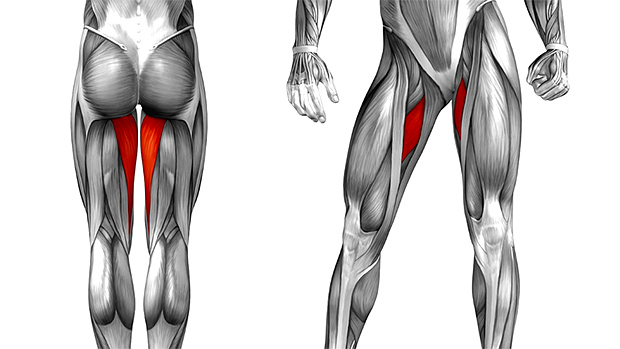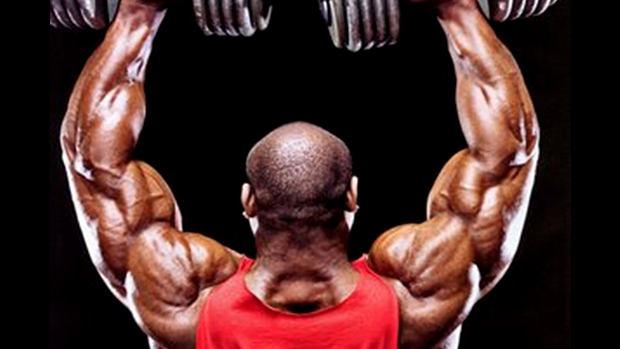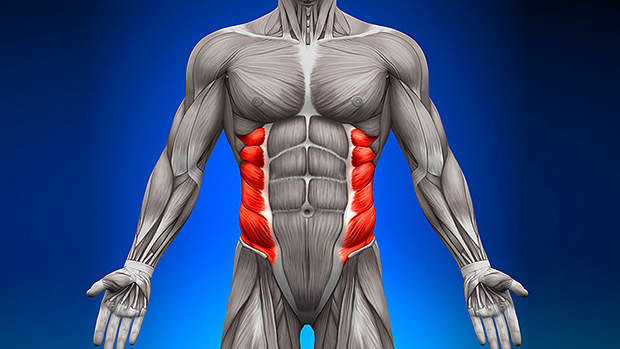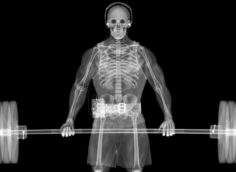I'm going to let you all in on a little secret: for five months last year, I spent roughly 5-6 hours a week in a room with two-dozen cadavers. No, it's wasn't some sick hobby, and I didn't live in a funeral home. Rather, I was fortunate enough to experience the marvel known as ATC 333: Gross Anatomy. Although I didn't walk away from this class with any good pickup lines, cute girls' phone numbers, or a newfound love of eau-de-formaldehyde, I did manage to emerge with a broader knowledge of human anatomy and, in turn, an expanded training perspective.
In particular, I realized that the hip adductors are the Rodney Dangerfields of the thigh; they get no respect. Unless one is completely shredded or...uh...dissected, it's impossible to truly appreciate the contribution of these muscles of less notoriety and prominence to strength and physique development.
Adduction refers to the movement of a limb toward the midline of the body in the frontal plane (also known as the coronal or lateral plane). When you do a jumping jack, the legs and arms both abduct (move away from the midline) during the up phase, and adduct as you return to the starting position. Understood? Good. Now when you poke fun at the clueless cottage cheesed-thighed housewives on those obstetrician machines at your gym, you'll have an educated term to back up your sarcasm. That said, we'll stay the hell away from both the machines and the housewives.
The adductor group consists of the adductor magnus, adductor brevis, adductor longus, gracilis, and pectineus. Together, the five muscles comprise the vast majority of the medial compartment of the thigh (1). Generally speaking, all of the muscles attach proximally on the pubis and ischium and distally on the linea aspera (posterior shaft) of the femur (2).

While adduction is the primary function of each, the amount of hip flexion present determines whether or not some of the adductors work on the femur as medial or lateral rotators and extensors or flexors (2). As odd as it may sound, the adductors are important as both hip flexors and extensors during the sprinting motion (3,4). Depending on the individual, the shift from flexor to extensor role occurs between 50 and 70 degrees of hip flexion. This phenomenon is possible due to the distal insertion point on the femur. When the hip is extended, the adductors' line of pull is anterior to the hip joint axis, whereas this line of pull is posterior to the axis when the hip is flexed (2).
Unfortunately, unless you're a horseback rider or breaststroker, the adductors receive little work in "ordinary" human movement (1). To further aggravate the "natural" lack of training, most training splits are geared solely toward hams and quads. Unless you're training with a very wide stance or significant amounts of unilateral exercises, you likely aren't hitting your adductors directly enough to realize their full growth potential. Additionally, while the hamstrings are predominantly fast-twitch in composition, the adductors usually have a greater proportion of slow-twitch fibers (5). As such, if you're partial to the time under tension school of thought, your low-rep hamstring training probably isn't doing much for your adductors (6).
In addition to size and strength shortcomings in your thighs, underdeveloped adductors can lead to another nasty problem: groin strains. Adductor strains are extremely common in sports that involve split-second changes in direction and the propulsion and acceleration that follow (7). In fact, it's estimated that 10% of all professional hockey injuries around the world are groin strains (8). Consider that this is a sport that involves checking, slashing, punching, disemboweling, ritualistic sacrifices of virgins, and the occasional torn supraspinatus from tossing an octopus on the ice, and you'll realize the significance of the 10% figure.
Just as we must be cognizant of the potential injuries that can result from an imbalance between the quads and hamstrings, we must recognize that the adductor/abductor strength ratio must be appropriate as well. The primary hip abductors are the gluteus medius and minimus (1). However, it's important to recognize that the larger and more powerful gluteus maximus has a slight abducting and lateral rotating effect during sprinting that must be counteracted by the adductor magnus (3,4). Along with core weakness, hip adductor weakness is a strong risk factor for groin strains (9). A prospective study of 47 National Hockey League players during the 2001 season yielded the following results:
- There were 11 total adductor muscle strains among eight players. In those eight players, average preseason hip adduction strength was 18% lower than that of the players that did not experience a groin injury.
- Players without adductor injuries demonstrated preseason adduction strength that was 95% of abduction strength (as determined from an instrumented manual muscle testing device). Conversely, in the injured players, this figure was only 78%.
- When a player's adductor strength was less than 80% of his abductor strength, he was 17 times more likely to suffer an adductor strain. (10)
- The eight injured players in question had 99% less sex than their uninjured teammates during the recovery period. The 1% consisted of some groupie with a fetish for "NHL shrinkage." Okay, I don't really have a reference for this, but I'm sure you can imagine how little action you'd be getting with an ice pack two inches from your unmentionables.
Additionally, those of you that suffer from patellofemoral pain syndrome might be interested to note that weak adductors are one of several potential causes for your persistent knee troubles. The origin of the vastus medialis oblique is at the tendon of the adductor magnus, so adductor based strength training merits inclusion in a rehabilitation program (11,12,13).
Let's take a closer look at the five muscles:
Adductor Magnus
The adductor magnus is by far the largest of the adductors of the thigh. As the diagram below shows, its size is second only to the vastus lateralis in the thigh, and actually dwarfs the hamstrings (biceps femoris, semitendinosus, and semimembranosus).

The adductor magnus originates on the ischium and pubis and has a broad insertion that extends along almost the entire length of the medial surface of the femur, culminating at the adductor tubercle (1). Because of its underappreciated role in hip extension, you can think of the adductor magnus as the more-recognized hip extensors' (hams, glutes, and erector spinae) fat, ugly prom date with a hairy mole; it's there, but no one wants to pay any attention to it!
Now, while there is little to be gained from associating with fat, ugly chicks with hairy moles, there's a lot of merit to focusing on your adductor magnus. Do yourself a favor and train it; you'll likely see noticeable improvements in your deadlift and squat poundages and overall thigh development. If being fast tickles your fancy more than moving big weights, you'll be interested to note that the adductor magnus rivals the hamstrings and gluteus maximus in terms of its contribution to sprinting speed (14).
Note: If you are a fat, ugly chick with a hairy mole, please do not send me threatening emails. I really am just a sensitive teddy bear on the inside; all the bodybuilders and powerlifters with whom I associate put me up to this macho outer shell. In other words, those threats and burning effigies should be directed to tc@t-mag.com.
Adductor Longus
The adductor longus is not quite as large as the adductor magnus and does not insert as distally on the femur as its larger counterpart. It does, however, still constitute a significant portion of the upper thigh. In fact, in the "typical" thigh pictured above, the adductor longus is cross-sectionally as large as the individual muscles of the hamstrings. Plus, given its position between the intermuscular septum and the larger superficial muscles, the adductor longus deserves mention as another one of the "pop 'em out muscles."

Gracilis
In addition to its role in hip adduction and internal rotation, the gracilis also contributes to knee flexion because of its attachment on the medial tibia (1). Just as it is important to train the hamstrings with both knee flexion and hip extension, training the gracilis along with the adductors can improve strength on leg curls and glute-ham raises, allowing for a carryover effect to more prominent hypertrophy.
Adductor Brevis and Pectineus
These two muscles are the smallest of the adductors. Because of their superior position, the adductor brevis and pectineus aren't likely to make your thighs massive. They do, however, contribute to proper biomechanics and structural balance at the hip joint.
Two highly effective ways to target the hip adductors are unilateral exercises and movements that use a wide stance (15,16,17,18). Contrary to popular belief and what mainstream muscle magazines preach, alterations to stance width and foot placement are not effective in changing emphasis within the quadriceps musculature from vastus lateralis to vastus medialis and vice versa. However, the burn that you feel along the inner thigh during sumo squats is indicative of increased adductor activity, not increased vastus medialis recruitment (18).
Perform the following every 5-7 days. This program should replace your hip dominant day if you use an Ian King-influenced split. Please note, however, that this program is contraindicated if you find that your knees tend to buckle inward when squatting. If that's the case, you'd be better off with a program that emphasizes stretching the adductors and tensor fascia latae/IT band while strengthening the gluteals, core, and vastus medialis. Given that tight adductors are just as common as weak adductors, this is an important diagnosis to make prior to the initiation of this program. Then again, unilateral work and wider stances tend to iron out the imbalances between the abductors and adductors, as the two muscle groups must be roughly equal in contribution, or else you tip over! Nonetheless, it's crucial to teach activation of the gluteals, core, and vastus medialis first; this program would therefore be a good progression.
A special thanks to Patricia Smith for posing for these exercise descriptions; I figured that most of you would rather look at her legs than mine (even if you don't give two left testicles about adductors). Plus, a little reminder that a woman can out-deadlift you might be just the kick in the pants you need to make serious progress...
A. Barbell Jump Lunge

- Sets: 6
- Reps: 3 per leg, switching positions in mid-air
- Tempo: Fast!
- Rest Interval: 90 seconds between sets
Start from a jump squat position with roughly 30% of your 1RM dynamic barbell lunge. With the scapulae pulled back and down, explode up and extend one leg forward in mid-air. Upon landing, immediately drive directly upward, once again propelling yourself into the air, where you'll extend the other leg forward and repeat twice for a total of 6 "landings." You should attempt to have as long a stride as possible, but most will find that these dynamic efforts require them to keep the front foot slightly closer to the body than with normal barbell lunges. This is a must for any athlete looking to prevent groin strains from occurring with powerful split-second changes in direction. I should note that Patricia was getting some serious hang-time in between pictures.
B. Sumo Deadlift

- Sets: 3
- Reps: 3,3,3
- Tempo: 20X0
- Rest Interval: 120 seconds
C1. Sumo Deadlift
- Sets: 3
- Reps: 5,5,5
- Tempo: 20X0
- Rest Interval: No rest; proceed immediately to C2.
C2. Walking Side Lunge to 30°

- Sets: 3
- Reps: 8-10 per leg (16-20 total steps)
- Tempo: 2020
- Rest Interval: 120 seconds between supersets and before D
D. Dumbbell Split Squat

- Sets: 2 per leg
- Reps: 20
- Tempo: 1010
- Rest Interval: 30 seconds
Training the adductors can make you a better squatter, deadlifter, and sprinter; reduce the likelihood of injury; and give you better-looking wheels. Even if you choose not to perform the program above, recognize the value of including wider stances and split stances in your training for enhancing performance and reducing injury potential. Above all, please note that I came through on my promise to keep you off of the obstetrician machine and away from the housewives. Now get to work!
- Floyd RT et al. Manual of Structural Kinesiology. McGraw Hill. 2001.
- Smith LK et al. Brunnstrom's Clinical Kinesiology: 5th Edition. F.A. Davis Company. 1996.
- Blazevich AJ. Optimizing hip musculature for greater sprint running speed. Strength and Conditioning Journal. 2000;22(2):22–27.
- Wiemann K et al. Relative activity of hip and knee extensors in sprinting: implications for training. New Stud Athletics. 1995;10(1):29–49.
- Poliquin C. Question of Strength. Testosterone Magazine. 26 June 1998.
- Poliquin C. Modern Trends in Strength Training: 2nd edition. 2001.
- Anderson MK et al. Sports Injury Management: 2nd Edition. Lippincott Williams & Wilkins. 2000.
- Nicholas SJ et al. Adductor muscle strains in sport. Sports Med. 2002;32(5):339-44. PubMed.
- Tyler TF et al. The effectiveness of a preseason exercise program to prevent adductor muscle strains in professional ice hockey players. Am J Sports Med. 2002 Sep-Oct;30(5):680-3. PubMed.
- Tyler TF et al. The association of hip strength and flexibility with the incidence of adductor muscle strains in professional ice hockey players. Am J Sports Med. 2001 Mar-Apr;29(2):124-8. PubMed.
- Zappala FG et al. Rehabilitation of patellofemoral joint disorders. Orthop Clin North Am. 1992;23:555-66.
- Callaghan MJ et al. The role of quadriceps exercise in the treatment of patellofemoral pain syndrome. Sports Med. 1996;21:384-91. PubMed.
- LaBrier K et al. Patellofemoral stress syndrome. Current concepts. Sports Med. 1993;16:449-59. PubMed.
- Delecluse C. Influence of strength training on sprint running performance. Current findings and implications for training. Sports Med. 1997 Sep;24(3):147-56. PubMed.
- McCurdy K et al. Unilateral support resistance training incorporating the hip and knee. Strength and Conditioning Journal. 2003 Apr;25(2):45–51.
- Hefzy MS et al. Co-activation of the hamstrings and quadriceps during the lunge exercise. Biomed Sci Instrum. 1997;33:360-5. PubMed.
- Green DL et al. Role of adductor longus and adductor magnus in postural movements and in ambulation. Am J Phys Med. 1970 Aug;49(4):223-40. PubMed.
- McCaw ST et al. Stance width and bar load effects on leg muscle activity during the parallel squat. Med Sci Sports Exerc. 1999 Mar;31(3):428-36. PubMed.





